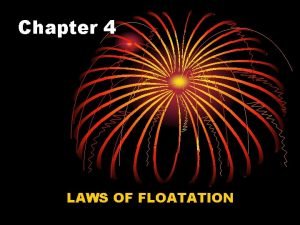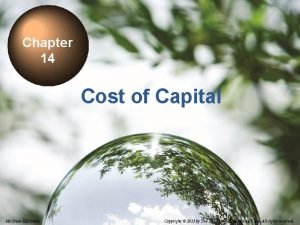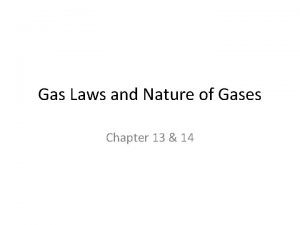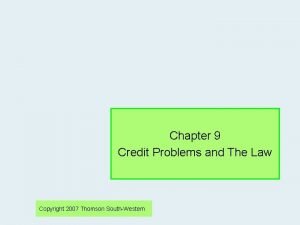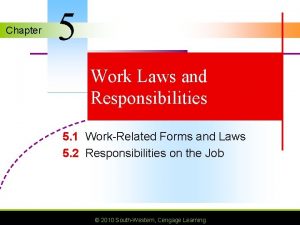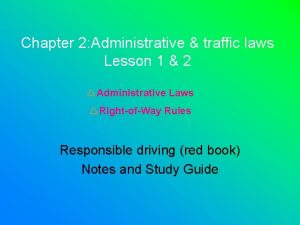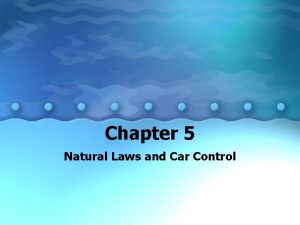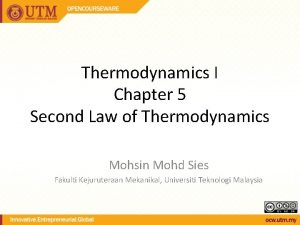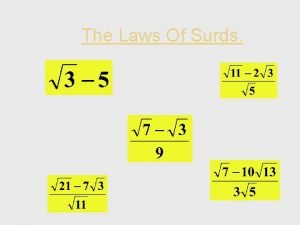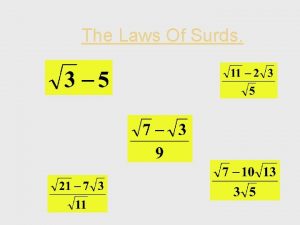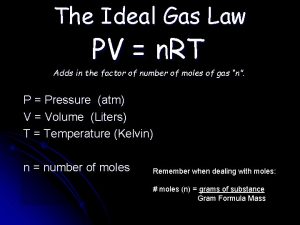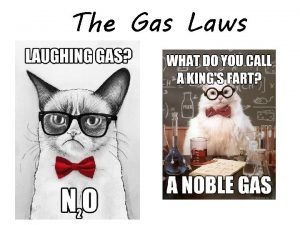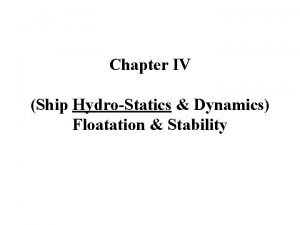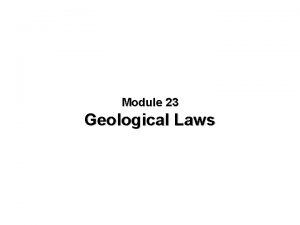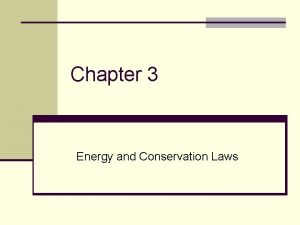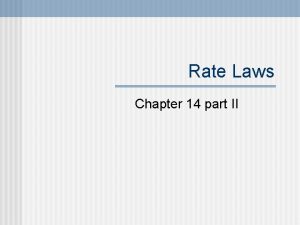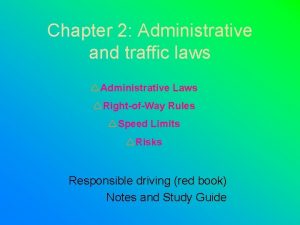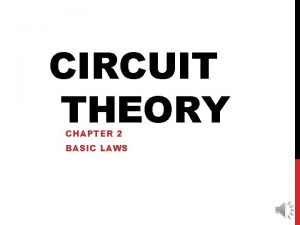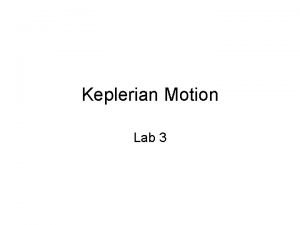Chapter 4 LAWS OF FLOATATION Laws of floatation
































- Slides: 32

Chapter 4 LAWS OF FLOATATION

Laws of floatation • Archimedes’ Principle When a body is wholly or partially immersed in a fluid it appears to suffer a loss in mass equal to the mass of fluid it displaces.

Laws of floatation

Example: When a box measuring 1 cu. m and of 4000 kg mass is immersed in fresh water it will appear to suffer a loss in mass of 1000 kg. If suspended from a spring balance the balance would indicate a mass of 3000 kg. In Air 4000 k. g 1 cubic meter In Fresh water 3000 k. g 1 cubic meter 4000 k. g

Laws of floatation

Laws of floatation

Laws of floatation

Laws of floatation

Laws of floatation 10 m 3 5 tons 5 m 3 5 tons 4 m 3 5 tons

Laws of floatation 10 m 3 5 m 3 0 ton 4 m 3 1 ton

5 tons Resultant force = zero G B 5 tons

the box shown in Figure (a) has a mass of 4000 kg, but has a volume of 8 cu. m. If totally immersed in fresh water it will displace 8 cu. m of water, and since 8 cu. m of fresh water has a mass of 8000 kg, there will be an up thrust or force of buoyancy causing an apparent loss of mass of 8000 kg. The resultant apparent loss of mass is 4000 kg. When released, the box will rise until a state of equilibrium is reached, i. e. when the buoyancy is equal to the mass of the box. To make the buoyancy produce a loss of mass of 4000 kg the box must be displacing 4 cu. m of water. This will occur when the box is floating with half its volume immersed, and the resultant force then acting on the box will be zero.

The box to be floating in fresh water with half its volume immersed. If a mass of 1000 kg be loaded on deck the new mass of the body will be 5000 kg, and since this exceeds the buoyancy by 1000 kg, it will move downwards. The downwards motion will continue until buoyancy is equal to the mass of the body. This will occur when the box is displacing 5 cu. m of water and the buoyancy is 5000 kg,

Laws of floatation

Laws of floatation

Laws of floatation

Laws of floatation

Laws of floatation

Laws of floatation

Tons Per Centimeter (TPC) • The TPC is the mass which must be loaded or discharged to change a ship’s mean draft by one centimeter in salt water

Tons Per Centimeter TPC (TPC) W =? ? W 1 L 1 One cm W one centimeter L

Tons Per Centimeter (TPC) • TPC = WPA X DENISTY 100 • WPA is the water plan area in meters • DENISTY of sea water is in ton/m 3 • DENISTY of sea water is 1. 025 ton/m 3 • TPC = WPA X 1. 025 100

TPC in dock water When a ship is floating in dock water of a relative density other than 1. 025 the weight to be loaded or discharged to change the mean draft by 1 centimetre (TPC dw) may be found from the TPC in salt water (TPC sw) by simple proportion as follows: TPC dw RELATIVE DENSITY dw = TPC sw RELATIVE DENSITY sw

TPC curves When constructing a TPC curve the TPCs are plotted against the corresponding drafts. It is usually more convenient to plot the drafts on the vertical axis and the TPCs on the horizontal axis.

The force of buoyancy is provided by the volume of the enclosed spaces under the water line Reserve buoyancy is the volume of the enclosed spaces above the water line

Reserve Buoyancy

Reserve buoyancy The volume of the enclosed spaces above the waterline are not providing buoyancy but are being held in reserve. If extra weights are loaded to increase the displacement, these spaces above the waterline are there to provide the extra buoyancy required It may be expressed as: • Volume or, • Percentage Of The Total Volume

Reserve Buoyancy

Reserve Buoyancy



 Laws of floatation
Laws of floatation Floatation cost
Floatation cost Wacc example
Wacc example Floatation cost
Floatation cost Floatation energy
Floatation energy Methods of floatation in primary market
Methods of floatation in primary market Useless laws weaken the necessary laws
Useless laws weaken the necessary laws Ideal gas law problems
Ideal gas law problems Chapter 5 natural laws and car control worksheet answers
Chapter 5 natural laws and car control worksheet answers Natural laws and car control chapter 9
Natural laws and car control chapter 9 Chapter 9 credit problems and laws
Chapter 9 credit problems and laws Chapter 5 work laws and responsibilities
Chapter 5 work laws and responsibilities Chapter 5 natural laws and car control
Chapter 5 natural laws and car control Chapter 2 administrative and traffic laws
Chapter 2 administrative and traffic laws Administrative laws apply only to traffic violations.
Administrative laws apply only to traffic violations. Chapter 17 records
Chapter 17 records Chapter 3 healthcare laws and ethics
Chapter 3 healthcare laws and ethics A vehicle's momentum depends on its
A vehicle's momentum depends on its Chapter 1 laws and their ethical foundation
Chapter 1 laws and their ethical foundation Chapter 5 natural laws and car control
Chapter 5 natural laws and car control Chapter 2 administrative and traffic laws
Chapter 2 administrative and traffic laws Laws and their ethical foundation
Laws and their ethical foundation Nc sunshine law
Nc sunshine law Why do some youth challenge authority and break laws
Why do some youth challenge authority and break laws Laws of the 12 tables
Laws of the 12 tables Module 3 topic 1 laws of nature
Module 3 topic 1 laws of nature The more laws and edicts are imposed
The more laws and edicts are imposed Cornelius vanderbilt industry
Cornelius vanderbilt industry Pmm1 in thermodynamics
Pmm1 in thermodynamics Laws of surds
Laws of surds Laws of surd
Laws of surd Gas laws crash course
Gas laws crash course Combined gas law direct or indirect
Combined gas law direct or indirect
